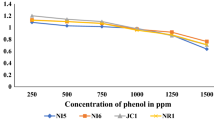Abstract
One of the most common taste and odour compounds (TOCs) in drinking water is 2-methylisoborneol (2-MIB) which cannot be readily removed by conventional water treatments. Four bacterial strains for degrading 2-MIB were isolated from the surface of a biological activated carbon filter, and were characterized as Micrococcus spp., Flavobacterium spp., Brevibacterium spp. and Pseudomonas spp. based on 16S rRNA analysis. The removal efficiencies of 2-MIB with initial concentrations of 515 ng·L−1 were 98.4%, 96.3%, 95.0%, and 92.8% for Micrococcus spp., Flavobacterium spp., Brevibacterium spp. and Pseudomonas spp., respectively. These removal efficiencies were slightly higher than those with initial concentration at 4.2 mg·L−1 (86.1%, 84.4%, 86.7% and 86.0%, respectively). The kinetic model showed that biodegradation of 2-MIB at an initial dose of 4.2 mg·L−1 was a pseudo-first-order reaction, with rate constants of 0.287, 0.277, 0.281, and 0.294 d−1, respectively. These degraders decomposed 2-MIB to form 2-methylenebornane and 2-methyl-2-bornane as the products.
Similar content being viewed by others
References
Sagehashi M, Shiraishi K, Fujita H, Fujii T, Sakoda A. Adsorptive ozonation of 2-methylisoborneol in natural water with preventing bromate formation. Water Research, 2005, 39(16): 3900–3908
Izaguirre G, Hwang C J, Krasner S W, McGuire M J. Geosmin and 2-methylisoborneol from cyanobacteria in three water supply systems. Applied and Environmental Microbiology, 1982, 43(3): 708–714
Rosen A A, Mashni C I, Safferman R S. Recent developments in the chemistry of odour in water: the cause of earthy-musty odour. Water Treatment and Examination, 1970, 19(2): 106–119
Tabachek J L, Yurkowski M. Isolation and identification of bluegreen algae producing muddy odor metabolites, geosmin and 2-methylisoborneol, in saline lakes in Manitoba. Journal of the Fisheries Research Board of Canada, 1976, 33(1): 25–35
Mills O E, Chung S Y, Johnsen P B. Dehydration products of 2-methylisoborneol are not responsible for off-flavour in the channel catfish. Journal of Agricure and Food Chemistry, 1993, 41(10): 169–1692
Sugiura N, Nishimura O, Inamori Y, Ouchiyama T, Sudo R. Grazing characteristics of musty-odor-compound-producing Phormidium tenue by a microflagellate, Monas guttula. Water Research, 1997, 31(11): 2792–2796
Westerhoff P, Rodriguez-Hernandez M, Baker L, Sommerfeld M. Seasonal occurrence and degradation of 2-methylisoborneol in water supply reservoirs. Water Research, 2005, 39(20): 4899–4912
Guttman L, van Rijn J. 2-Methylisoborneol and geosmin uptake by organic sludge derived from a recirculating aquaculture system. Water Research, 2009, 43(2): 474–480
Drikas M, Dixon M, Morran J. Removal of MIB and geosmin using granular activated carbon with and without MIEX pre-treatment. Water Research, 2009, 43(20): 5151–5159
Cook D, Newcombe G, Sztajnbok P. The application of powdered activated carbon for MIB and geosmin removal: predicting PAC doses in four raw waters. Water Research, 2001, 35(5): 1325–1333
Tennant MF, Mazyck DW. The role of surface acidity and pore size distribution in the adsorption of 2-methylisoborneol via powdered activated carbon. Carbon, 2007, 45(4): 858–864
Ho L, Hoefel D, Bock F, Saint C P, Newcombe G. Biodegradation rates of 2-methylisoborneol (MIB) and geosmin through sand filters and in bioreactors. Chemosphere, 2007, 66(11): 2210–2218
Lalezary S, Pirbazari M, McGuire M J. Oxidation of five earthymusty taste and odor compounds. Journal-American Water Works Association, 1986, 78(3): 62–69
Tanaka A, Oritani T, Uehara F, Saito A, Kishita H, Niizeki Y, Yokota H, Fuchigami K. Biodegradation of a musty odour component, 2-methylisoborneol. Water Research, 1996, 30(3): 759–761
Ho L, Newcombe G, Croué J P. Influence of the character of NOM on the ozonation of MIB and geosmin. Water Research, 2002, 36(3): 511–518
Izaguirre G, Wolfe R L, Means E G III. Degradation of 2-methylisoborneol by aquatic bacteria. Applied and Environmental Microbiology, 1988, 54(10): 2424–2431
Izaguirre G, Wolfe R L, Means E G. Bacterial degradation of 2-methylisoborneol. Water Science and Technology, 1988, 20(8–9): 205–210
Egashira K, Ito K, Yoshiy Y. Removal of musty odor compound in drinking water by biological filter. Water Science and Technology, 1992, 25(2): 307–314
Lauderdale C V, Aldrich H C, Lindner A S. Isolation and characterization of a bacterium capable of removing taste- and odor-causing 2-methylisoborneol from water. Water Research, 2004, 38(19): 4135–4142
Yagi M, Nakashima S, Muramoto S. Biological degradation of musty odour compounds, 2-methylisoborneol and geosmin, in a bioactivated carbon filter. Water Science and Technology, 1988, 20(8–9): 255–260
Sumitomo H. Odor decomposition by the yeast Candida. Water Science and Technology, 1988, 20(8–9): 157–162
Zhou B H, Wang J, Cai M M, Zhu L, Song W J. Isolation of a bacterium capable of removing 2-methylisoborneol from water. Journal of University of Science and Technology Beijing, 2007, 29(S2): 227–230 (in Chinese)
Zhou B H, Yuan R F, Yu L Y, Gu J N, Zhang C L. Isolation and characterization of bacterium capable of removing 2-methylisoborneol from drinking water. In: Proceeding of 2010 International Conference on Electrical and Control Engineering (theWorkshop on Environment, Construction and Transportation), Wuhan, China, 2010, 5114–5117 (in Chinese)
Schmidt S K, Alexander M, Shuler M L. Predicting threshold concentrations of organic substrates for bacterial growth. Journal of Theoretical Biology, 1985, 114(1): 1–8
Rubin H E, Alexander M. Effect of nutrients on the rates of mineralization of trace concentrations of phenol and p-nitrophenol. Environmental Science & Technology, 1983, 17(2): 104–107
Rittmann B E, Gantzer C J, Montiel A. Biological treatment to control taste-and-odor compounds in drinking water treatment. In: Suffet I H, Mallevialle J, Kawczynski E, eds. Advances in Tasteand-Odor Treatment and Control. American Water Works Association Research Foundation, Denver, USA, 1995, 209–246
Sumitomo H. Biodegradation of 2-methylisoborneol by gravel sand filtration. Water Science and Technology, 1992, 25(2): 191–198
Schumann R, Pendleton P. Dehydration products of 2-methylisoborneol. Water Research, 1997, 31(5): 1243–1246
Author information
Authors and Affiliations
Corresponding author
Rights and permissions
About this article
Cite this article
Yuan, R., Zhou, B., Shi, C. et al. Biodegradation of 2-methylisoborneol by bacteria enriched from biological activated carbon. Front. Environ. Sci. Eng. 6, 701–710 (2012). https://doi.org/10.1007/s11783-011-0367-6
Received:
Accepted:
Published:
Issue Date:
DOI: https://doi.org/10.1007/s11783-011-0367-6




